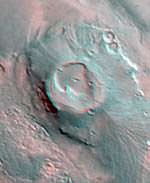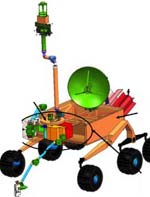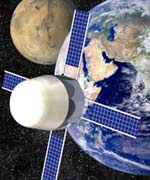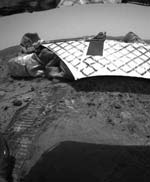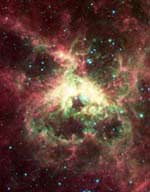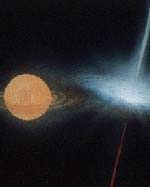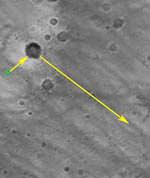
Image credit: NASA
NASA announced on Thursday that it would be reorganizing aspects of the agency to better support the new vision of space exploration laid out by George Bush earlier in the week. The Office of Exploration Systems was created, and will be led by Craig Steidle to build the equipment that will take humans back to the Moon. A special committee was appointed by the President, and is expected to deliver a more concrete plan for the space initiative within four months.
In a move designed to align the agency with the new exploration agenda outlined yesterday by President George W. Bush, NASA Deputy Administrator Frederick D. Gregory announced a comprehensive restructuring of the offices within Headquarters in Washington.
The alignment impacts NASA management, the strategic Enterprises, and the agency’s functional offices. The new alignment goes into effect immediately and reflects the new vision and the results of a comprehensive review of Headquarters operations, which first began when Gregory became Deputy Administrator in 2002.
Retired U.S. Navy Rear Admiral Craig E. Steidle is the new Associate Administrator, Office of Exploration Systems. Since retiring from the Navy in March, 2000, he has been an independent aerospace consultant. He was Chief Aerospace Engineer and Vice Commander, Naval Air Systems Command, which develops, acquires and supports naval aeronautical systems, when he retired.
The Office of Exploration Systems is established to set priorities and direct the identification, development, and validation of exploration systems and related technologies. Users and technologists will work together to enable a balancing of factors between requirements, program schedules and costs.
Steidle entered the Navy after graduating with merit from the United States Naval Academy, Annapolis, Md. He trained as an attack pilot, test pilot and test pilot instructor. Steidle commanded the Navy’s F/A-18 Program, naval aviation’s largest production, research and development program, as well as the largest Foreign Military Sales Program. The Secretary of Defense presented Steidle with the Navy’s Outstanding Program Manager Award. While Director of the Joint Strike Fighter Program, the program was awarded the David Packard Excellence in Acquisition Award.
Steidle earned Master of Science degrees in Systems Management and Aerospace Engineering. He is a member of the Society of Experimental Test Pilots and is a Fellow of the Royal Aeronautical Society.
Dr. J. Victor Lebacqz is the new Associate Administrator, Office of Aeronautics, which was previously known as the Office of Aerospace Technology. He has served as Acting Associate Administrator of the Office of Aerospace Technology since July 2003. He was appointed as Deputy Associate Administrator in December 2002.
The new Office of Aeronautics was created to reflect NASA’s commitment to aviation research and aeronautics technologies for the nation’s civil and defense interests.
“This alignment gives us the ability to specifically focus on our aeronautics and exploration systems,” Gregory said. “These management adjustments will give us new opportunities for more effective leadership, policy and program success.”
The changes are consistent with NASA’s ongoing responses to the management and cultural issues addressed by the Columbia Accident Investigation Board. “We live in a different world than we did just a few years ago, and our management structure should reflect the priorities and objectives of our commitments,” Gregory added.
The Office of the NASA Administrator will be streamlined to allow for more independent leadership in areas vital to the execution of NASA’s vision and mission. Among the changes, three new independent offices will be created.
The new offices include:
* The Office of Chief Engineer is established to ensure agency development efforts and mission operations are planned and conducted using sound engineering
* The Office of Health and Medical Systems is established to ensure the well-being of the NASA workforce and to provide independent oversight authority for healthcare, related research and information
* The Office of the Chief Information Officer is established to manage the agency’s Information Technology (IT) investments, lead the development of an IT strategic plan, and create a roadmap to guide the agency’s IT programs and policies.
* The Office of Institutional and Corporate Management (Code O) is established to lead the oversight of NASA’s management systems, institutional, and corporate activities
Leadership for the new offices, as well as staffing requirements and resource allocations, will be addressed as the new alignment is implemented this calendar year.
For additional information about NASA and management programs on the Internet, visit:
Original Source: NASA News Release

